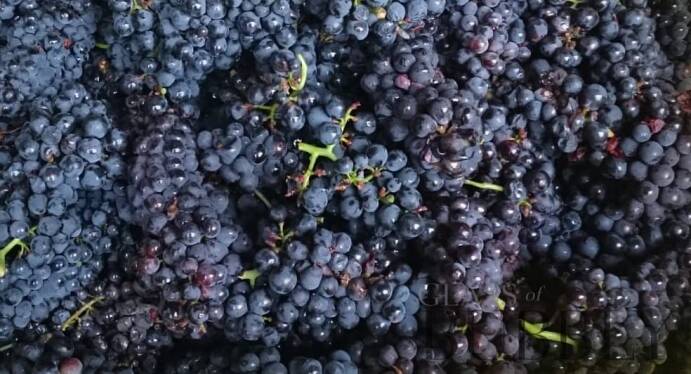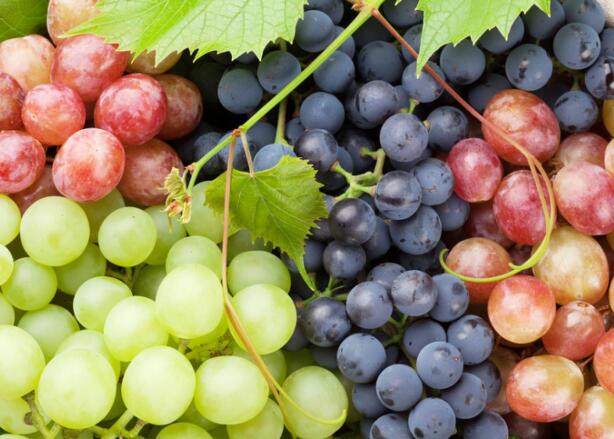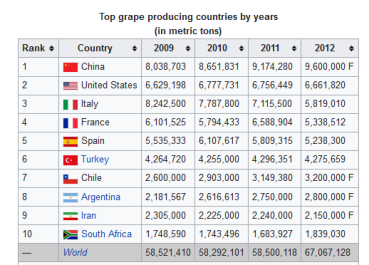A grape is a fruit, botanically a berry, of the deciduous woody vines of the flowering plant genus Vitis.
Grapes can be eaten fresh as table grapes, used for making wine, jam, grape juice, jelly, grape seed extract, vinegar, and grape seed oil, or dried as raisins, currants and sultanas. Grapes are a non-climacteric type of fruit, generally occurring in clusters.
History
The Middle East is generally described as the homeland of grape and the cultivation of this plant began there 6,000–8,000 years ago. Yeast, one of the earliest domesticated microorganisms, occurs naturally on the skins of grapes, leading to the discovery of alcoholic drinks such as wine. The earliest archeological evidence for a dominant position of wine-making in human culture dates from 8,000 years ago in Georgia.
The oldest known winery was found in Armenia, dating to around 4000 BC. By the 9th century AD, the city of Shiraz was known to produce some of the finest wines in the Middle East. Thus it has been proposed that Syrah red wine is named after Shiraz, a city in Persia where the grape was used to make Shirazi wine.
Ancient Egyptian hieroglyphics record the cultivation of purple grapes, and history attests to the ancient Greeks, Cypriots, Phoenicians, and Romans growing purple grapes both for eating and wine production. The growing of grapes would later spread to other regions in Europe, as well as North Africa, and eventually in North America.
In 2005 a team of archaeologists concluded that some Chalcolithic wine jars, which were discovered in Cyprus in the 1930s, were the oldest of their kind in the world, dating back to 3,500 BC. Moreover, Commandaria, a sweet dessert wine from Cyprus, is the oldest manufactured wine in the world, its origins traced as far back as 2000 BC.
In North America, native grapes belonging to various species of the genus Vitis proliferate in the wild across the continent, and were a part of the diet of many Native Americans, but were considered by early European colonists to be unsuitable for wine. In the 19th century, Ephraim Bull of Concord, Massachusetts, cultivated seeds from wild Vitis labrusca vines to create the Concord grape which would become an important agricultural crop in the United States.
Description
Grapes are a type of fruit that grow in clusters of 15 to 300, and can be crimson, black, dark blue, yellow, green, orange, and pink. "White" grapes are actually green in color, and are evolutionarily derived from the purple grape. Mutations in two regulatory genes of white grapes turn off production of anthocyanins, which are responsible for the color of purple grapes.[12] Anthocyanins and other pigment chemicals of the larger family of polyphenols in purple grapes are responsible for the varying shades of purple in red wines.[13][14] Grapes are typically an ellipsoid shape resembling a prolate spheroid.
Description
Grapes are a type of fruit that grow in clusters of 15 to 300, and can be crimson, black, dark blue, yellow, green, orange, and pink. "White" grapes are actually green in color, and are evolutionarily derived from the purple grape. Mutations in two regulatory genes of white grapes turn off production of anthocyanins, which are responsible for the color of purple grapes.[12] Anthocyanins and other pigment chemicals of the larger family of polyphenols in purple grapes are responsible for the varying shades of purple in red wines.[13][14] Grapes are typically an ellipsoid shape resembling a prolate spheroid.
Nutrition
Raw grapes are 81% water, 18% carbohydrates, 1% protein, and have negligible fat (table). A 100-gram (3+1⁄2-ounce) reference amount of raw grapes supplies 288 kilojoules (69 kilocalories) of food energy and a moderate amount of vitamin K (14% of the Daily Value), with no other micronutrients in significant content.
Grapevines
Most domesticated grapes come from cultivars of Vitis vinifera, a grapevine native to the Mediterranean and Central Asia. Minor amounts of fruit and wine come from American and Asian species such as:
Vitis amurensis, the most important Asian species
Vitis labrusca, the North American table and grape juice grapevines (including the Concord cultivar), sometimes used for wine, are native to the Eastern United States and Canada.
Vitis mustangensis (the mustang grape), found in Mississippi, Alabama, Louisiana, Texas, and Oklahoma
Vitis riparia, a wild vine of North America, is sometimes used for winemaking and for jam. It is native to the entire Eastern United States and north to Quebec.
Vitis rotundifolia (the muscadine), used for jams and wine, is native to the Southeastern United States from Delaware to the Gulf of Mexico.
Table and wine grapes
Commercially cultivated grapes can usually be classified as either table or wine grapes, based on their intended method of consumption: eaten raw (table grapes) or used to make wine (wine grapes). While almost all of them belong to the same species, Vitis vinifera, table and wine grapes have significant differences, brought about through selective breeding. Table grape cultivars tend to have large, seedless fruit (see below) with relatively thin skin. Wine grapes are smaller, usually seeded, and have relatively thick skins (a desirable characteristic in winemaking, since much of the aroma in wine comes from the skin). Wine grapes also tend to be very sweet: they are harvested at the time when their juice is approximately 24% sugar by weight. By comparison, commercially produced "100% grape juice", made from table grapes, is usually around 15% sugar by weight.
Seedless grapes
Seedless cultivars now make up the overwhelming majority of table grape plantings. Because grapevines are vegetatively propagated by cuttings, the lack of seeds does not present a problem for reproduction. It is an issue for breeders, who must either use a seeded variety as the female parent or rescue embryos early in development using tissue culture techniques.
There are several sources of the seedlessness trait, and essentially all commercial cultivators get it from one of three sources: Thompson Seedless, Russian Seedless, and Black Monukka, all being cultivars of Vitis vinifera. There are currently more than a dozen varieties of seedless grapes. Several, such as Einset Seedless, Benjamin Gunnels's Prime seedless grapes, Reliance, and Venus, have been specifically cultivated for hardiness and quality in the relatively cold climates of northeastern United States and southern Ontario.
Health claims
Comparing diets among Western countries, researchers have discovered that although French people tend to eat higher levels of animal fat, the incidence of heart disease remains low in France. This phenomenon has been termed the French paradox, and is thought to occur from protective benefits of regularly consuming red wine, among other dietary practices. Alcohol consumption in moderation may be cardioprotective by its minor anticoagulant effect and vasodilation.
Although adoption of wine consumption is generally not recommended by health authorities, some research indicates moderate consumption, such as one glass of red wine a day for women and two for men, may confer health benefits. Alcohol itself may have protective effects on the cardiovascular system.











سبد خرید
